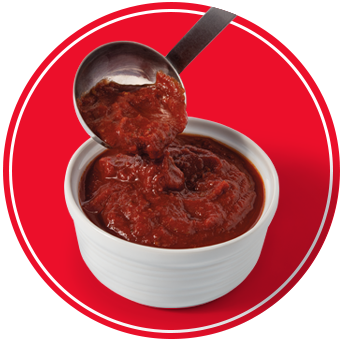Pizza, in its myriad forms, is a global comfort food beloved for its versatility and the sheer joy it brings to the dining table. At the heart of every memorable pizza is not just the dough or the toppings but the sauce—a component that truly has the power to elevate the overall flavor of a pizza. A great pizza sauce recipe is the unsung hero of pizza night, providing the foundational flavor that complements every topping it meets. In this guide, we aim to explore a variety of pizza sauce recipes, from classic tomato-based sauces to innovative creations that promise to surprise and delight your taste buds. Whether you're a seasoned chef or a home cook looking to make homemade pizza sauce, there's something here for everyone. By mastering how to make pizza sauce, you're on your way to elevating your pizza game, turning a simple homemade pizza into a gourmet experience.
The Basics of Pizza Sauce
Understanding Pizza Sauce
What sets pizza sauce apart from other sauces isn't just its ingredients but its role in harmonizing with the dough and toppings. Unlike sauces that serve as a side or topping, pizza sauce is integral to the pizza's overall composition, melding flavors across each layer. The best pizza sauce recipes understand this balance, crafting a sauce that enhances without overwhelming and starts with a foundation of the right ingredients.
Essential Ingredients
A traditional homemade pizza sauce typically includes:
- Tomatoes: The backbone of most pizza sauces, providing acidity, sweetness, and body.
- Olive Oil: Adds richness and helps carry the flavors of the herbs and spices.
- Garlic: For depth and aroma.
- Herbs: Such as oregano, basil, and sometimes thyme or rosemary, which offer freshness and complexity.
- Salt: To enhance all the other flavors.
These staple ingredients can be adjusted or built upon but provide a solid foundation for creating an authentic pizza sauce.
Classic Tomato-Based Pizza Sauce
The Classic Recipe
Creating a traditional tomato-based pizza sauce recipe starts with the right blend of simplicity and flavor. Here's how to make pizza sauce that's perfect for almost any topping:
Ingredients:
- 1 can (28 ounces) of crushed tomatoes
- 2 tablespoons olive oil
- 2-3 garlic cloves, minced
- 1 teaspoon sugar (optional, to balance acidity)
- 1 teaspoon dried oregano
- 1 teaspoon dried basil
- Salt to taste
Instructions:
- In a medium saucepan, heat the olive oil over medium heat. Add the minced garlic and sauté until fragrant, about 1 minute.
- Pour in the crushed tomatoes, and add the oregano, basil, and sugar if using. Stir to combine.
- Bring the mixture to a simmer, then reduce the heat to low. Let the sauce simmer for 20-30 minutes, stirring occasionally. The longer it simmers, the more the flavors will meld together.
- Season with salt to taste. Allow the sauce to cool before spreading on your pizza dough.
Selecting the Best Tomatoes
The quality of your tomatoes can make or break your homemade pizza sauce. For the richest and most savory sauce, look for canned San Marzano tomatoes, renowned for their sweet flavor and low acidity. However, any high-quality canned crushed tomatoes will work well in a pinch.
Seasoning to Perfection
The secret to a flavorful sauce is in the seasoning. Start with the recommended amounts of herbs, then adjust based on your taste preferences. Remember, the sauce will be spread thinly over the pizza, so its flavors must be concentrated to shine through the dough and toppings.
By following these guidelines, you're well on your way to creating a classic pizza sauce that's rich, savory, and the perfect complement to your homemade pizza creations.
Creative Variations to Traditional Pizza Sauce
Expanding beyond the classic tomato base opens up a world of flavors for your homemade pizzas. These creative pizza sauce recipes are perfect for those looking to add a unique twist to their pizza night.
Spicy Arrabbiata Sauce
For those who love a bit of heat, a Spicy Arrabbiata pizza sauce recipe brings both spice and depth to your pizza:
Ingredients:
- 1 can (28 ounces) of crushed tomatoes
- 2 tablespoons olive oil
- 3-4 garlic cloves, minced
- 1-2 teaspoons red pepper flakes (adjust to taste)
- 1 teaspoon dried basil
- Salt to taste
Instructions:
- In a saucepan, heat the olive oil over medium heat. Add the garlic and red pepper flakes, sautéing until the garlic is golden and fragrant.
- Stir in the crushed tomatoes and basil. Bring to a simmer.
- Reduce heat to low and let the sauce simmer for 20-30 minutes. The longer it cooks, the more the flavors will develop and meld.
- Season with salt to taste. Allow the sauce to cool before using it as your homemade pizza sauce base.
Creamy White Garlic Sauce
Move over, red sauce; this creamy, garlic-infused white sauce is perfect for a decadent pizza base:
Ingredients:
- 2 tablespoons butter
- 4 garlic cloves, minced
- 2 tablespoons all-purpose flour
- 1 cup heavy cream
- 1/2 cup grated Parmesan cheese
- Salt and pepper to taste
- A pinch of nutmeg (optional)
Instructions:
- In a saucepan, melt the butter over medium heat. Add the minced garlic and sauté until fragrant, about 1 minute.
- Whisk in the flour until a paste forms. Gradually add the heavy cream, whisking constantly to prevent lumps.
- Stir in the grated Parmesan cheese until the sauce is smooth and creamy. Season with salt, pepper, and a pinch of nutmeg if desired.
- Let the sauce simmer on low heat for a few minutes until it thickens to your liking. Remove from heat and let it cool slightly before applying it to your dough.
Pesto Pizza Sauce
For a fresh and herbaceous alternative, try this vibrant pesto sauce on your next pizza:
Ingredients:
- 2 cups fresh basil leaves
- 1/2 cup olive oil
- 1/3 cup pine nuts or walnuts
- 2 garlic cloves
- 1/2 cup grated Parmesan cheese
- Salt and pepper to taste
Instructions:
- In a food processor, combine basil leaves, olive oil, nuts, garlic, and Parmesan cheese. Blend until smooth, scraping down the sides as needed.
- Season the pesto with salt and pepper to taste. If the pesto is too thick, add a little more olive oil until you reach the desired consistency.
- Spread a thin layer of pesto sauce over your pizza dough for a flavorful base that pairs wonderfully with a variety of toppings.
Simmering Your Way to Perfection
Techniques for Simmering
Simmering your pizza sauce recipe is key to developing a rich, concentrated flavor. Here are some tips for simmering your way to the perfect sauce:
- Use a heavy-bottomed saucepan to ensure even heat distribution and prevent burning.
- Keep the sauce at a low simmer; bubbling too vigorously can reduce volume too quickly and a burnt taste.
- Stir occasionally, more frequently as the sauce thickens, to prevent sticking and ensure even cooking.
Adjusting Thickness
The consistency of your homemade pizza sauce can significantly impact the final product. Here's how to achieve your desired sauce thickness:
- For a thicker sauce, let it simmer uncovered, allowing excess moisture to evaporate. Stir more frequently as the sauce reduces to prevent burning.
- For a thinner sauce, cover the saucepan with a lid to trap moisture or add a bit of water or broth to thin it out.
Enhancing Flavors with Herbs and Spices
The Role of Herbs and Spices
Herbs and spices are essential for transforming a good pizza sauce recipe into a great one. They add layers of flavor that can complement or contrast with your toppings.
Must-Try Combinations
Experiment with these herb and spice combinations to find your signature homemade pizza sauce flavor:
- Classic Italian: Oregano, basil, and thyme offer a traditional flavor profile.
- Spicy Kick: Red pepper flakes, smoked paprika, and cumin for those who like it hot.
- Herby Freshness: Rosemary, sage, and marjoram for a sauce with a fresh, aromatic twist.
By exploring these recipes and tips, you're well on your way to mastering how to make pizza sauce that's not just a base but a star in its own right, ensuring your homemade pizzas are nothing short of spectacular.
Customizing Your Sauce for Different Toppings
The beauty of crafting your homemade pizza sauce is the ability to tailor it to the toppings you plan to use. Each sauce can be a canvas for culinary creativity, ensuring a harmonious pizza experience from crust to topping.
Matching Sauce with Toppings
- Spicy Arrabbiata Sauce pairs wonderfully with toppings like spicy Italian sausage, jalapeños, or even pineapple for a sweet and spicy combination.
- Creamy White Garlic Sauce is a match made in heaven for earthy mushrooms, spinach, or chicken.
- Pesto Pizza Sauce brings out the best in fresh mozzarella, tomato slices, and basil, offering a fresh, Mediterranean flair.
Adapting Recipes for Unique Pizzas
Don't be afraid to tweak your pizza sauce recipes to complement more unconventional toppings. For example, a hint of curry powder in a tomato sauce can set the stage for a fusion pizza with tandoori chicken. The key is to consider the dominant flavors of your toppings and adjust your sauce to either contrast or enhance those notes.
Health-conscious and Dietary-friendly Sauces
Creating pizza sauce recipes that cater to health-conscious and dietary-restricted individuals means everyone can enjoy pizza night without compromise.
Low-Sodium Pizza Sauce
- Simply reduce or omit the salt in your recipe, and rely on fresh herbs and spices like basil, oregano, and garlic to boost the flavor profile.
Vegan and Gluten-Free Options
- Most traditional pizza sauces are naturally vegan and gluten-free, but always check your labels if you use canned products. For a creamy sauce alternative, consider cashew cream seasoned with nutritional yeast for a cheesy flavor.
The Art of Storing and Preserving Pizza Sauce
Maximizing the shelf life of your homemade pizza sauce allows you to have gourmet pizza sauce on hand whenever the craving strikes.
Storing for Short-Term Use
- Refrigerate your sauce in an airtight container for up to one week. Ensure the container is sealed properly to maintain freshness.
Freezing for Longevity
- Freezing is ideal for extending the life of your sauce. Pour the sauce into ice cube trays for individual pizza servings or freezer-safe bags for bulk storage. Use within 3-6 months for optimal flavor.
Canning Pizza Sauce
- For those interested in canning pizza sauce, ensure you follow a tested and safe canning recipe and process. Acidification might be necessary to ensure safety when canning tomato-based sauces.
Crafting the Perfect Slice: A Flavorful Farewell
The journey through how to make pizza sauce reveals that the heart of a great pizza lies in its sauce. By exploring different pizza sauce recipes, from the classic to the creative, and understanding how to pair and preserve them, you've equipped yourself with the knowledge to elevate your homemade pizzas from good to gourmet. Remember, the perfect pizza sauce is not just about the recipe but about how it brings your pizza to life, complementing the dough and toppings to create a harmonious and delicious eating experience. Whether you're crafting a sauce that's rich and savory, light and fresh, or somewhere in between, your homemade pizza nights are sure to be eagerly anticipated events, filled with flavors that delight and surprise with every bite.






